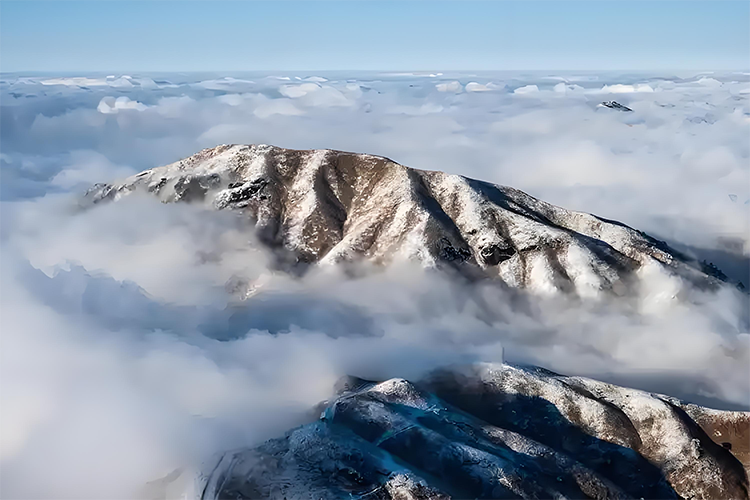Explore Wugong Mountain’s Alpine Meadows: Jiangxi’s Cloud Grassland Adventure
Introduction
When morning light slices through the mist, the 1,918-meter Golden Summit becomes a living painting — ten thousand acres of alpine meadow roll like an ocean, ruined ceremonial altars appear and vanish in the clouds, and the echo of chants seems to reach back 1,700 years. Praised by China National Geography as the “cloud grassland,” Wugong Mountain is an outdoor paradise that thrills hikers, mesmerizes photographers, and transports culture travelers through time.
1. The Natural Epic at Jiangxi’s Highest Peak
“Sea of clouds and meadows in motion, ancient altars conversing with crags” — this phrase captures Wugong Mountain’s soul. As the most spectacular stretch of the Luoxiao Range, the mountain boasts three standout features:
– Jiangnan’s rare alpine meadows: Ten thousand acres of highland grassland unfold across elevation bands — azaleas bloom into seas in May, emerald waves stretch to the horizon in August, golden seedheads ripple like grain in October, and rime turns the meadows into a crystal forest in December.
– A dramatic sea-of-clouds theater: With roughly 200 cloud-sea days per year, the most spectacular phenomenon is the “waterfall cloud” — clouds pouring over cliffs forming a kilometer-scale aerial waterfall. On fortunate mornings you may witness rainbows and the halo-like Buddha’s light together.
– Granite-sculpted peak gallery: Core areas like the Golden Summit (Jinding), Guanyin Dang, and Fayunjie each show unique rock character. Strange formations — Turtle Rock, the Immortal’s Guiding Finger — feel like an open-air sculpture park.
2. Millennia-old Altars and Taoist Secrets
Perched near a 1,600-meter cliff, the basalt foundation of Gexian Tan (Gexian Altar) still stands firm. Built in the Three Kingdoms era, it — together with Wangxian Tan and Qiushi Tan — forms the nation’s highest ancient ritual altar group. Examine the copper-coin patterns in stone joints and you read ancient beliefs in harmony between heaven and humanity. Every lunar August 1st, Taoist priests perform blessings along the Tang-dynasty trail, the incense trailing upward as if reenacting Ge Hong’s legendary alchemy.
3. The Ultimate Challenge for Outdoor Lovers
Lonely Planet calls Wugong one of East China’s must-conquer hikes. Three classic itineraries suit different tastes:
– Easy Experience (1 day): Ride the Golden Summit cable car up to about 1,600 m, stroll the cliffside boardwalk and tick off the cloud grassland.
– Hardcore Traverse (2–3 days): A 25 km crossing from Shenzi Village to Longshan Village. Camp under the alpine sky, watch the Milky Way, and let a pro guide point out Pleistocene glacial traces.
– Cultural Quest (1 day): Follow an archaeological map to ancient altars and join a grass-weaving intangible heritage workshop at Fayunjie.

4. Seasonal Survival Guide
– Best seasons: May–June for flower seas (15–25°C); September–October for autumn tones (bring a windproof jacket). Winter offers spectacular snowscapes but some trails close.
– Safety notes: Summer afternoons often host thunderstorms — summit by 13:00. Winter ice on meadows requires crampons. Locals say, “Wugong Mountain has four seasons in a day” — a hardshell plus quick-dry layers are essential.
5. Practical Travel Tips
– Getting there: From Nanchang or Changsha airports take high-speed rail to Pingxiang North (about 1.5 hours), then the park shuttle to Shigu Temple entrance (¥27, ~1 hour). Self-driving visitors can navigate to “Wugong Mountain Visitor Center”; parking costs about ¥20/day.
– Tickets: Peak season (Apr–Oct) ¥70, includes the museum; Zhong’an cable car ascending ¥65, Golden Summit cable car ¥35. Foreign passports enjoy a 20% discount.
– Accommodation: Golden Summit offers stargazing tent camps (¥300 per tent, breakfast included); mid-mountain hostels around Hanging Horse Stake provide dorm beds for around ¥100. Adventurous travelers can book the glass cliff house at Guanyin Dang for luxury.
– Hidden perks: Reserve one of the 20 daily “sea-of-clouds breakfasts” in advance to dine at 06:00 while waiting for sunrise. Park Wi‑Fi covers main viewpoints — live streaming is feasible.

Conclusion
When the last slant of sunset leaves the meadows, you will understand why explorer Xu Xiake wrote of “thousand peaks like emerald hairpins.” Wugong Mountain is not merely a sightseeing spot but an immersive dialogue between raw nature and resilient culture. Whether you measure ridgelines with your boots or touch the grooves of ancient altars, this cloud-hidden sanctuary always readies its most spectacular stage.


